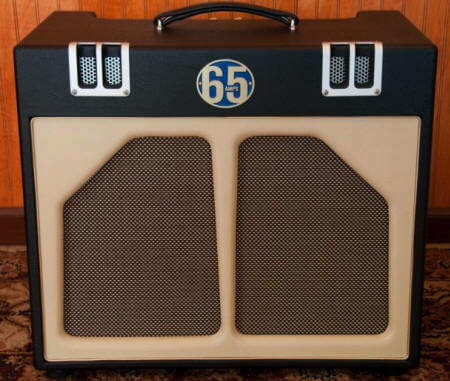
THE CREW AT 65 AMPS HAS A REPUTATION for putting considerable R&D sweat into every new amp design before it leaves the maker’s Los Angeles, California, headquarters. The Lil’ Elvis has, in the broad sense, been in development even longer than most — a stately 48 years or so, if you take into account its roots in an odd little combo owned by Vox collector and author Jim Elyea, one that Vox designer Dick Denney had built as his own personal amp, but which never went into production. Having seriously dug this prototype’s overdriven sound, 65 Amps’ Dan Boul and Peter Stroud set about tidying up the circuit, giving it a usable clean voice and a much broader vocabulary, and making it into a versatile — yet still quite simple — club-gig and studio amp for the contemporary tone fiend. The result is 65’s most diminutive offering yet, both in physical stature and output level, but as we shall see, the stated “clean output” of 12 watts can be deceiving, and this isn’t the mere bedroom brawler that such a rating might imply.
The format hints at a blend of American and British small-amp templates: from this side of the pond, a quirky split-phase inverter similar to that of Fender’s Princeton Reverb and a “bias wiggler” tube tremolo circuit not unlike that used by some Gibson and Ampeg models — from the other side of the pond, the dual EL84 output tube complement and EZ81 tube rectifier. And from California circa 2009, plenty of fresh thinking in the form of the Bump and Master Voltage circuits and the squat, chunky cab, as well as the considerable effort that went into transformer design (with Mercury Magnetics), grounding and filtering topologies, and noise reduction techniques. The Lil’ Elvis is also a somewhat simpler affair than other 65 products, and comes in at a little less coin as a result. Its Bump feature is fixed — rather than having its own Tone and Level controls like the one on the SoHo and Stone Pony — though it is footswitchable (from a pedal that also includes a stomp button for the tremolo), and EQ is limited to a single Tone control. There’s also an enigmatic Smooth switch that has no noticeable affect on clean settings, but does exactly as it says when you crank the amp up, by engaging a circuit that keeps the grid from lifting up from ground when you go into heavy distortion, thereby reducing crossover distortion at the output stage. The final control on the panel, labeled Master, actually governs a proprietary “master-voltage” circuit that lowers the preamp and power tubes’ output levels while retaining filament voltage and, hence, is purported to preserve tonal vocabulary and playing feel.
The stout 21″ wide x 18 high ” x 11.5″ deep cab wears the traditional 65 Amps two-tone cosmetics with aluminum front-edge cooling vents, and houses a single Celestion G12H-30 speaker. Inside, the workmanship lives up to everything I’ve come to expect from this high-end maker, offering a superb example of handcrafted tube amp manufacture. Of the whole package as it sits, my only minor gripe might be that it’s tricky to change the horizontally mounted tubes, requiring a blind grope inside the cab, but it’s easy enough flip the whole chassis outward, panel still attached, to do the job more carefully. Oh, and why “Lil’ Elvis”? In Boule’s own words: “No matter how small you make Elvis, he still rocks.”
I tested the Lil’ Elvis with a Fender Telecaster, a Collings 290 with Lollar P90s, and a Gibson SG with humbuckers. Played clean, it issued classic blackface-Fender-style tones, with piano-like lows and silky highs, with good headroom up to higher Volume settings than I would have expected. Cranked up, this sonic template segues into a surprisingly convincing Marshall half-stack impersonation. There’s a juicy midrange that isn’t over-baked, surprisingly solid low-end thump, and velvety smooth highs that really help your lead playing to soar — especially with the Smooth switch engaged. Stomping on Bump makes everything thicker and bigger, enabling serious rock lead and rhythm work alike from this deceptive little amp. And although it would be nice to be able to set the amount of extra boost that this feature introduces, it’s still a groovy option. The Master control works as it should, retaining body and character as you lower the output level, but it does increase the depth of your given tremolo Intensity setting, an unexpected quirk, but one that’s not too problematic given that you’ll most likely adjust it and leave it — and likewise set Speed and Intensity to taste — before you launch into playing. For its own part, this output-bias modulating tremolo circuit is a real sweetie, adding rich, chewy, chop to your sound and attaining a sense of depth and vibe at higher Intensity settings that must be heard to be appreciated.
Containing a few nods to classic amps of the early ’60s, but tied together with a lot of original design work, Lil’ Elvis is one chunky bundle of surprises. This top-notch tone machine is surprisingly versatile despite its simplicity, and it sounds way bigger and badder than you’d ever imagine 12 watts could provide. So if you’re gunning for a low-power amp that wields some serious mojo, Lil’ Elvis is the ass-kicker you’ve been waiting for.
SPECS:
CONTACT 65 Amps, (818) 760-5089, 65amps.com
MODEL Lil’ Elvis
PRICE $2,150 retail/street price N/A
CHANNELS One
CONTROLS Volume, Tone, Depth, Speed, Master, Smooth switch, Bump switch
POWER 12 watts
TUBES Three 12AX7 preamp tubes, two EL84 output tubes, one EZ81 rectifier
EXTRAS Series effects loop, two-button footswitch jack, dual speaker outs, switch for 8Ω & 16Ω impedance
SPEAKER Celestion G12H-30 (16Ω)
WEIGHT 49 lbs
KUDOS Great build quality. First-class clean and overdrive tones. Surprising versatility.
CONCERNS Tubes are tricky to change without removing chassis; tremolo strength increases as Master Voltage is decreased.
Source: https://mercurymagnetics.com/pages/news/GuitarPlayer/GPDec09.htm